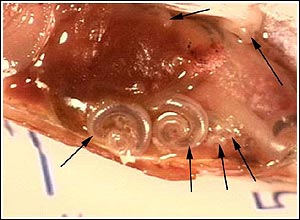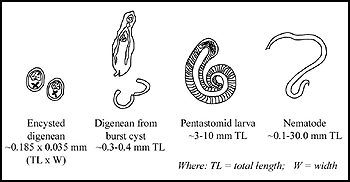

 |
||||||||||||
 |
||||||||||||
| Pentastomid Infections in Fish | ||||||
| Page 2 of 3 | Pages: 1 . 2 . 3 | |||||
Disease in Fish Caused by Pentastomes The appearance of the fish, as well as the amount of tissue damage done by the parasite, will depend on the fish species infected, whether or not the fish has been infected before, and the species and number of pentastomes present. In one published report (Boyce et. al. 1987), little damage was seen in infected mosquitofish, whereas the same species of parasite caused significant damage and inflammation in infected swordtails. Necropsy of the swordtails revealed several clinical findings: prominent swellings of the skin, tracks where parasites had migrated through muscle, and encapsulated juvenile (nymph) stages present in the body cavity as well as under connective tissue of many organs. In some infected fish examined at the University of Florida's Tropical Aquaculture Laboratory, there were obvious swellings in the skin and muscle from which nymph stages were extracted. Conversely, other fish had relatively few external signs of the parasite, however, in some of these fish, significant numbers of parasites were seen internally during necropsy ( Figure 3 ). One swordtail had over 200 pentastomes of various sizes located throughout its body. 
Figure 3: Pentastome larvae (nymphs) in the body cavity of a swordtail. Note varying sizes and locations of pentastomes (arrows). Diagnosis and Treatment Affected fish may have grub-like lesions within the skin and muscle, however, infections can occur within internal organs of fish with no external signs present. Common characteristics of pentastomes ( Figure 4 ) include: a short body length relative to body diameter (compared with nematodes); obvious segmentation (annuli) of the body (nematodes are not segmented); small hooks on the anterior (head) end; and a coiled nymph stage. In contrast, digenean trematodes in fish are usually found as immature metacercariae (a larval stage in an oval, encysted form). If these cysts are broken, the digenean trematodes that emerge appear flatter and have circular oral and ventral suckers. 
Figure 4: Comparison of digenean trematode, pentastome nymph, and nematode sizes. Because pentastomes can be found encapsulated in many different locations within fish, there are no treatments other than prevention. Chemical treatments to kill stages in the water have not been evaluated. Affected fish typically must be culled. Depending upon the severity of infection within a population, anywhere from a few percent to as high as 30 percent of the fish in a pond may be affected. Consequently, it is important that infections are recognized early so that preventative measures can be instituted as soon as possible. more ... |
 |
|||||
| About Us :: Message Board :: Chat | |||||
| Library :: Photo Gallery :: Links & Resources :: Breeders & Sponsors :: Merchandise | |||||
| Website designed by: EthanCote.com | © 2001-2004, SimplyDiscus.com. All Rights Reserved. | ||||